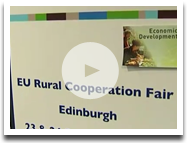The Strategy Implementation
Why cooperate with other regions?
Types of cooperation
Cooperation is one of the fundamental specific features and sources of the innovation and added-value of the LEADER method. It encourages and supports LAGs to undertake joint actions with other LAGs, or with a group taking a similar approach, in another region, Member State, or even a third country. Two main types of cooperation are noted by the European Commission in their ‘Guide for the Implementation of the measure for cooperation under the current Rural Development Program's (RDP) LEADER axis. These are:
Inter-territorial cooperation. This refers to cooperation between different rural areas within a Member State. Cooperation within a Member State concerns at least one LAG selected under the LEADER axis and it is open to other local groups using a similar participatory approach.
Transnational cooperation (TNC). This is defined as cooperation between different rural areas from at least two Member States. Transnational cooperation covers at least one LAG selected under the LEADER axis and additional partners could include other local groups using similar participatory approach. It is also possible to extend this cooperation to groups in third countries following a similar approach.
Joint actions
Cooperation projects correspond to concrete actions with clearly identified deliverables producing benefits for each of the territories involved. These actions must be ‘joint' in the sense that they are being jointly implemented. The content of such joint actions may cover a range of different activities eligible under the RDPs' rules.
Eligible costs
Joint approaches allow LAGs from one area to contribute funding to joint project that may be happening in another territory. The location of the project is not a limiting factor if the LAG area benefits from the joint project actions. Examples of eligible joint actions (subject to national rules for RDP implementation) include capacity building or knowledge transfer via common publications, training seminars, twinning arrangements (exchange of LAG Managers and staff) leading to the adoption of common methodological and working methods, or to the elaboration of a joint or coordinated development work.
Transnational cooperation adding value
Cooperation can provide local projects with a new dimension, since these types of projects provide stakeholders with alternative and novel opportunities to look for and solve issues in innovative ways. Cooperation projects are capable of producing different types of added-value:
-
Making projects more ambitious by reaching critical mass
TNC enables a project to achieve a greater critical mass, since the total benefits are much greater than the sum of individual achievements (1+1=11). Pooling resources and expertise can result in economies of scale and synergies, which are favorable to help achieving project objectives (such as costs for technical equipment/technologies, training, marketing, etc.). -
Improving competitiveness: finding new business partners, positioning on new markets
Implementing a project with transnational partners can help the promotion of local products and the area of their origin. TNC may provide access to new business opportunities, hence generating a potential for increased product sales, new product or process design and additional know-how. In contrast to potential competition, cooperation enables the partners to take advantage of the complementarities, and to benefit from the similarities. -
Supporting work and promoting innovation through new skills
New visions and new dimensions can support and promote new ways of working. Furthermore, exposure to transnational experiences can help broaden business horizons and encourage companies or organizations to adopt improved operational approaches. These in turn should generate knock-on socio-economic and/or environmental benefits for rural areas. -
Developing territorial identity and raising awareness
TNC can help local people discover their area and history. By improving the understanding of their own territory, transnational interactions can lead to local actors becoming more open to represent their territory, and thereby becoming true ‘ambassadors' of their areas. -
Strengthening of territorial strategy and local partnerships
TNC projects are linked to the territory and the respective local development strategies of the cooperation partners. These projects help to meet the needs and challenges addressed in the strategies of the cooperating areas.
Start with short steps
Building up a well-grounded transnational cooperation project is a long process requiring patience. There are many organizations like the ENRD, ELARD and National Rural Networks helping you on this road. Start with short steps so that you can keep the right direction:
"The LAG started late 2003 with mutual visits to test cooperation possibilities with other LAGs in countries around the Baltic and the North Sea. The visits were usually followed by development workshops around agreed topics, as a first step towards a formalised cooperation project. We are now in 2007 networking with 15 LAGs in Denmark, Sweden, Finland, Lithuania, Poland, Germany and England, and we are participating in four different cooperation projects. Our strategy has been to develop cooperation over the long term with the expectation that the cooperation projects create an added value of 5% of our development turnover."
(Vestsjælland LAG, Denmark).
The LEADER Sub-Committee Focus Group 3 on Cooperation found four main difficulties that are worth taking into consideration when implementing the cooperation measure:
o Different timing in decision-making and different administrative rules in different Member States,
o Different expectations towards beneficiaries in different LEADER strategy documents,
o Variable information needs of different partners involved in cooperation,
o Difficulty in identification of the most relevant thematic areas where cooperation would be needed.






